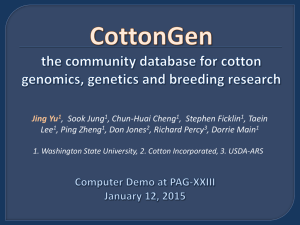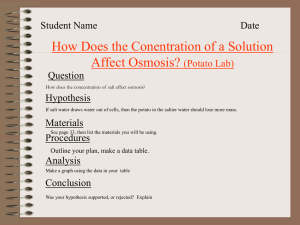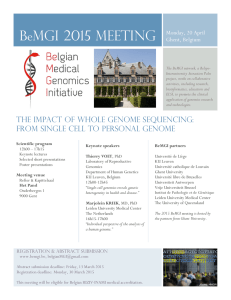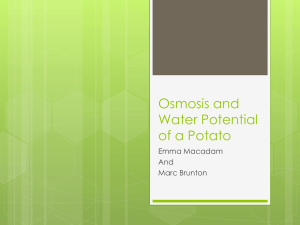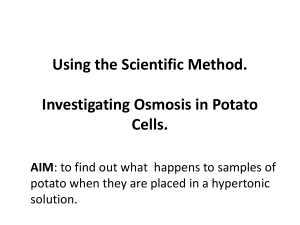Basic science
advertisement
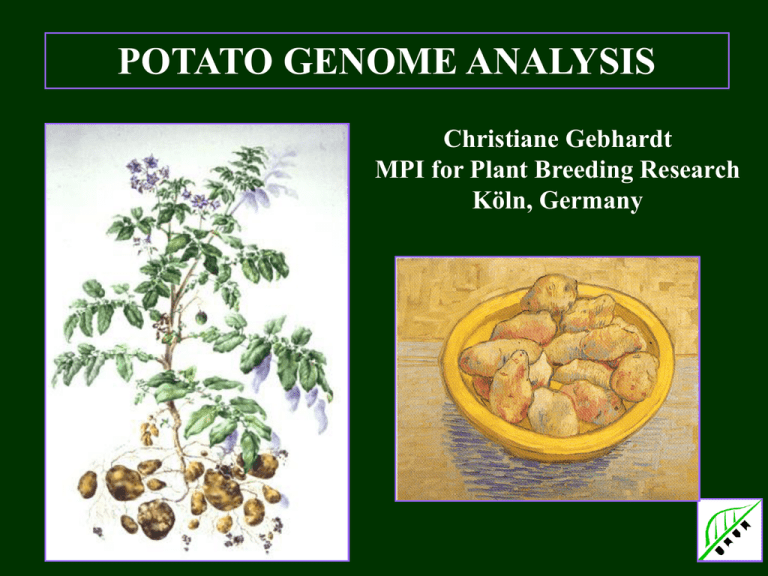
POTATO GENOME ANALYSIS Christiane Gebhardt MPI for Plant Breeding Research Köln, Germany Potatoes are like humans: Self-incompatible outbreeders. (A x B) x (C x D) crosses. All wild types. Large biodiversity. Differences: Ploidy level: 4n and 2n. Large experimental F1 families possible Vegetative propagation. Genome size 1/3 of human genome: ~ 1000 Mbp. Long term goals • to elucidate the genetic basis of complex agronomic characters of potato at the molecular level; • to contribute to the understanding of structure, function and natural diversity of crop plant genomes; • to contribute to the genetic improvement of the cultivated potato by developing molecular diagnostic tools to assist the breeding of new cultivars. Basic science Genome structure and evolution Molecular basis of QTL for agronomic traits Association studies Selective genomic sequencing Comparative maps Biodiversity, haplotypes Candidate genes Function maps for pathogen resistance and tuber traits Molecular maps Applied science Haplotype-based plant breeding Markers for population-based MAS Engineering agronomic traits R-gene cloning Markers for pedigree-based MAS Comparing the crop genome (genetic map) with the model genome (physical map) A a B b c C A. thaliana, 121 Mbp mb S. tuberosum, ca. 1000 Mbp cM Ch. Gebhardt MPIZ COMPARATIVE MAPPING WITH ESTs and STS MARKERS CONSERVED BETWEEN POTATO AND ARABIDOPSIS (EuDicotMap): 1. Linkage maps of 12 potato chromosomes were constructed based on 445 RFLP loci. 2. Marker sequences were compared to the Arabidopsis genomic sequence (BLASTN: P < exp -10, BLASTX: P < exp - 15) RESULTS 1. 321 RFLP loci in potato have multiple sequence similarity with the Arabidopsis genome sequence (1500 „hits“). 2. Ca. 41 % of the potato genetic map have syntenic relationships with ca. 50 % of the Arabidopsis physical map. Some potato chromosomes have more syntenic relationships with the Arabidopsis genome than others. Syntenic blocks are redundant. Potato map segments detect ancient duplications in the Arabidopsis genome. Gebhardt et al. 2003, TPJ 34: 529 Synteny between different potato map segments and the same Arabidopsis genome segment reveals ‚hidden‘ intra- and interchromosomal duplications in the potato genome. Similar experiments, comparing sugar beet (Beta vulgaris), sunflower (Helianthus annuus) and Prunus spp with Arabidopsis thaliana, based on different sets of EST markers, give similar results. A.tha. 2 rDNA I-II B mb 1 2 Sugar beet Sun flower Prunus Potato 3 4 5 6 7 8 II-IV A 9 10 11 12 I-II A 13 14 I-II C 15 16 II-III A 17 18 19 20 Dominguez et al. 2003, PBJ 1: 91 Genome Archeology Comparing the genomes of contemporary, distantly related plant species ‚excavates‘ the remains of an ancestral plant genome. Ch. Gebhardt MPIZ Basic science Genome structure and evolution Molecular basis of QTL for agronomic traits Association studies Selective genomic sequencing Comparative maps Biodiversity, haplotypes Candidate genes Function maps for pathogen resistance and tuber traits Molecular maps Applied science Haplotype-based plant breeding Markers for population-based MAS Engineering agronomic traits R-gene cloning Markers for pedigree-based MAS Potato function map for tuber traits I GP264 II Icdh-1 GP1(c) GP23 SK2 CP100 III rbcS-c GluA GP180(a) Pk AGPaseB-c GMPase rbcS-1 GP303 Me-a Pain-1 GluB CP11 PC116 Cis GP293(a) GP255(i) CP18 Fbp-cy AGPaseS-c CP6 SssI Pha1-b Tk GP88 GP504 GP276 Pha1-a Ppe-a Aldolase-pl Prk G6pdh GP35(d) Sut4 GP82 GP35(t) CP113 Fk CP104(d) Starch QTL GP76 SbeI GP295 VII VIII GbssI/wx Ppa1-b Pgk-cp Pme Aco Glo-a AGPaseB-a GP40(a) GP92 Ldh2-a prp1 CP20(a) GP167(b) AGPaseS-b Mdh Glo-b Ppc-a Fbp-cp Ucp Ppa2 FBA Inv-ap-b SbeII XI GP122 UGPase GP125 ShkB Dbe GP218 Sut1 Rca FBA Ndpk StpH XII CP49(a) CP280 Tal1 Ant pat(a) Ppa1-a GP183 Fum1-b Sus4 GP129 Pha2 Sugar QTL GP308(b) GP215(a) Inv-ap-a Ppe-c GP171 Fum1-a X GP35(e) GP27 GP181 Hxk IX CP137(b) CP43 Gb-R1 Ppe(b) Pfp-a CP132 CP134(b) GP211 Me-b GP194 GP127 Yield QTL Sut2 Pdh-E1 GapC-cy Gpt GP179 GP234 rbcS-2 GP79 Stp1 UPTG Dpe-P GP35(p) SssIII Pfp-b PSTR(f) GP186 VI Agl GP261 GP1(a) GP26 V IV Pt2 Ldh2-b Ppa1-c GP185 GP254 Sus3 Sps GP34 Pt1 PSTR(i) Starch metabolism Sugar metabolism Transport, energy Ppc-b AGPaseB-b All genes functional in carbohydrate metabolism, regulation and transport are candidate genes. RESPIRATION GLYCOLYSIS GapC DEGRADATION AMY STP Ppa Starch PPi Hexose-P Sbe Sucrose-P SPS S6P PPi Sucrose SUS UGP AGP UDP-Glc ADP-Glc SYNTHESIS INV Glucose Fructose SS Amyloplast After Sowokinos 2001, Am. J. Pot. Res. 78 Cytoplasm Fructose Vacuole Cell wall IX prp1 CP137(b) CP20(a) GP167(b) Fbp-cp Ucp Ppa2 FBA Inv-ap-b SbeII Ndpk StpH GP35(e) Fum1-b GP129 GP254 PSTR(i) Pt1 Co-localization of a functional candidate gene (invertase) with QTL for tuber sugar content (Menendez et al. 2002, Genetics 162). The example of candidate gene association mapping of: CHIP COLOR The color of potato chips and French fries depends on the glucose and fructose content of raw tubers. High sugars, Low sugars Bad chips Li Li et al. (2005) Genetics 170: 813 Good chips Single strand conformation polymorphism (SSCP) of Invap in tetraploid breeding pools Chips quality depends on fructose and glucose content of tubers. Invertase allele d is associated with chips quality (P < 0.001) in a breeding pool of 179 tetraploid genotypes. Thanks for your attention Funding: European Union (EuDicotMap) BMBF (German Federal Ministry for Education and Research), GABI-CHIPS. MPG (Max-Planck society).


